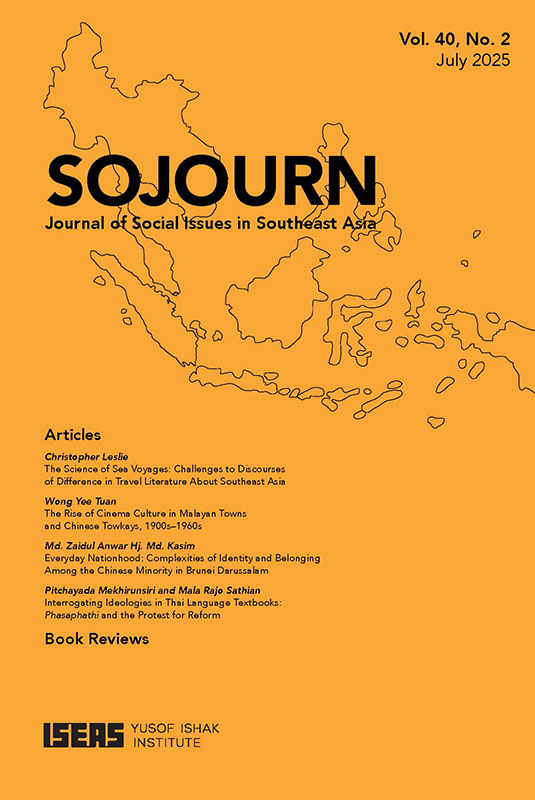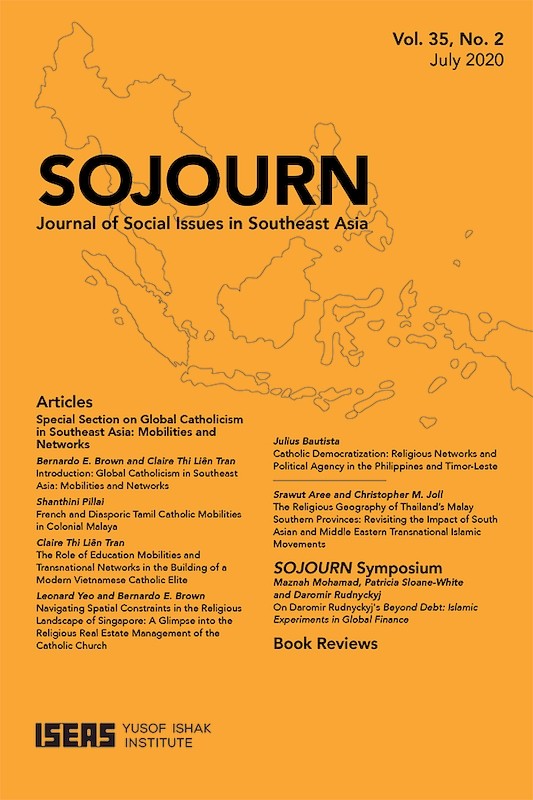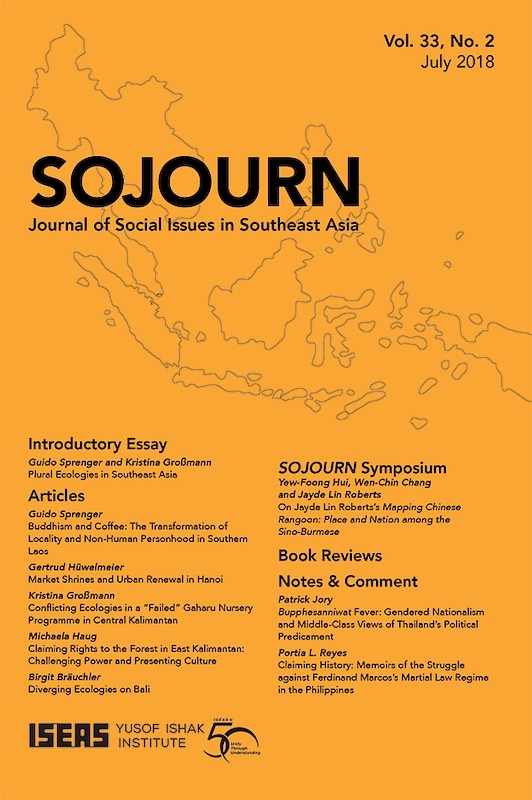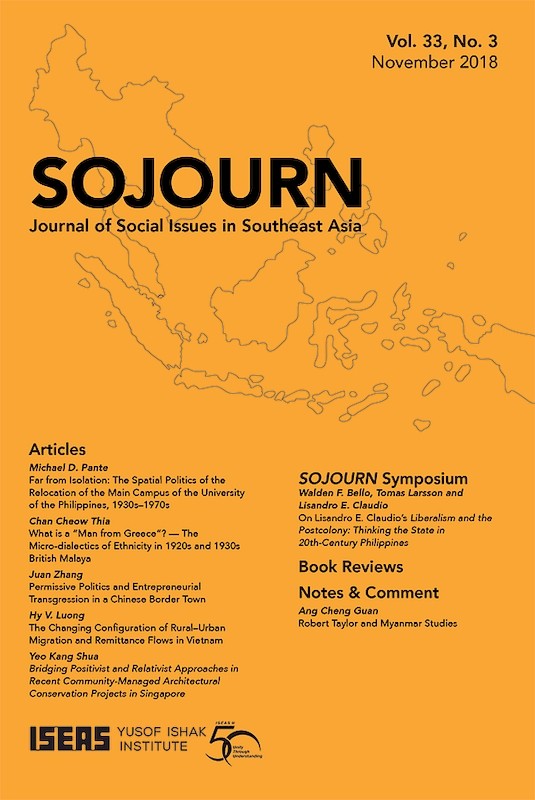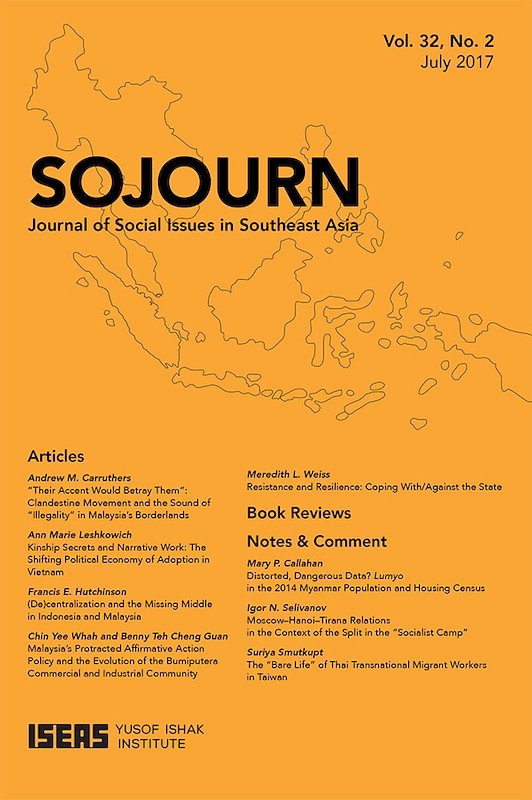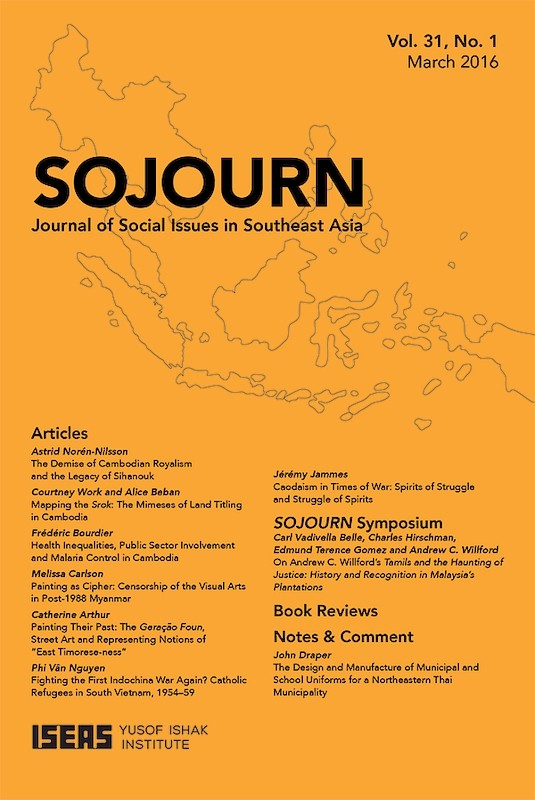SOJOURN Vol. 33/1 (March 2018) and Vol. 33/S (Supplement 2018)
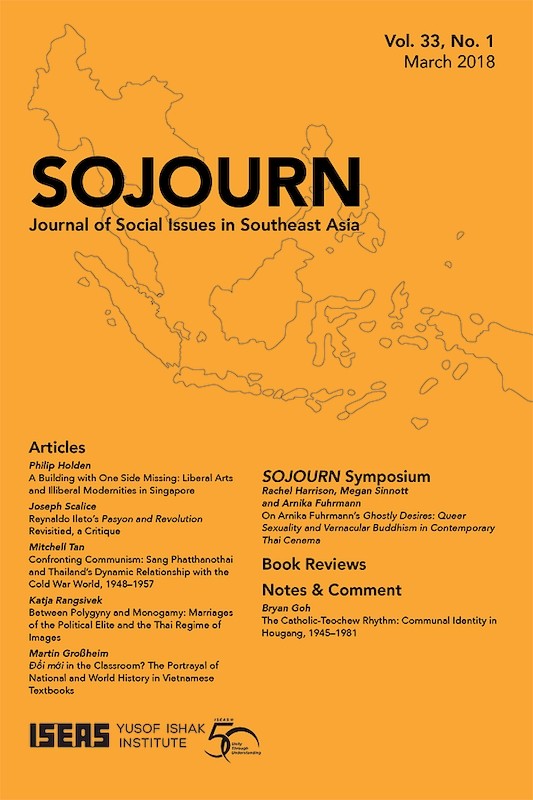
Date of publication:
March 2018
Publisher:
ISEAS - Yusof Ishak Institute
Number of pages:
264
Code:
SJ33/1
About the publication
To mark the fiftieth anniversary of the founding of the ISEAS – Yusof Ishak Institute, SOJOURN is publishing not only the regular March issue but also a special supplementary issue highlighting the journal’s contribution to the study of Southeast Asia during the past three decades.
Contents
-
SOJOURN: Journal of Social Issues in Southeast Asia Vol. 33/1 (March 2018)
[Whole Publication, ISSN: 17932858] -
Preliminary pages
- ARTICLES
-
A Building with One Side Missing: Liberal Arts and Illiberal Modernities in Singapore, by Philip Holden, author see abstractRaffles College, Singapore’s first comprehensive institution of higher education, brought a particular pedagogical community into being from its opening in 1928 to its temporary closure during the Pacific War in December 1941. Two areas of tension at the college were the incorporation of Asia and Asians as subjects and objects of study into the humanities curriculum, and forms of subjectification incited by residentially based pedagogy. The experience of the college, viewed through the lens of the present, asks us to revisit issues that remain pertinent in contemporary Singapore and in questions relating more broadly to the development of higher education in Asia.
-
Reynaldo Ileto’s Pasyon and Revolution Revisited, a Critique, by Joseph Scalice, author see abstractReynaldo Ileto’s 1979 work <i>Pasyon and Revolution: Popular Movements in the Philippines, 1840–1910</i>, attempted to reconstruct the categories of perception of “the masses” by using the religious performance of the suffering and death of Christ, the <i>pasyon</i>, as source material. Critical re-examination of his work reveals that the attempt was deeply flawed. It engaged with the <i>pasyon</i> as a literary text, ignored the significance of its performance and treated it in an ahistorical manner. An attentiveness to performance demonstrates that the <i>pasyon</i> was a cross-class and linguistically specific phenomenon. This insight dramatically attenuates the argumentative force of Ileto’s claim to provide an historical understanding of the consciousness of the masses and their participation in revolution.
-
Confronting Communism: Sang Phatthanothai and Thailand’s Dynamic Relationship with the Cold War World, 1948–1957, by Mitchell Tan, author see abstractAs a highly influential political figure in the Second Phibun era (1948–57), Sang Phatthanothai charted unique paths for the Thai nation-state in the emerging Cold War. In multifarious roles — as labour organizer, newspaper editor and back-channel diplomat — Sang orchestrated Thai connections with both the People’s Republic of China and transnational anti-communist organizations like the spiritual Moral Re-Armament movement in the 1950s. An intellectual and political history of his career reveals a flexible and adaptive vision of Thailand’s relationship with international developments in the post-war world. Governing this vision was Sang’s dynamic assessment of what best protected the Thai nation’s identity and independence.
-
Between Polygyny and Monogamy: Marriages of the Political Elite and the Thai Regime of Images, by Katja Rangsivek, author see abstractThe polygynous marriages of Thai kings traditionally fulfilled a range of vital political functions. Comparison between those marriages and the marriages of politicians active in the post-1932 constitutional regime era illustrate the continuing political significance of marriage in Thailand. Polygyny has become highly contextualized with different sections of Thai society operating according to varying marital norms. Performative monogamy is thus necessary. This situation suggests weaknesses in the Thai regime of images as it relates to the notional separation between public and private spheres and to the idea of multiple truths. Neither applies to the marriages of members of the Thai political elite.
-
Ɖổi mới in the Classroom? The Portrayal of National and World History in Vietnamese Textbooks, by Martin Großheim, author see abstractExamination of the treatment in Vietnamese history textbooks of national and world history against the backdrop of the collapse of socialism in the Soviet Union and Soviet Bloc countries suggests that the authors of these textbooks fear that what happened in the Soviet Union could also happen in Vietnam. The purpose of the textbooks’ depiction of the past is to allay these fears. The textbooks reflect Vietnam’s turn back towards China after the dissolution of the Soviet Union and of socialist countries in Eastern Europe. For the leadership in Hanoi, the emphasis on fraternal ties with China has, however, recently lost its allure. Beijing’s actions in the South China Sea have, in turn, prompted many Vietnamese to demand a more comprehensive coverage of Sino–Vietnamese relations in history textbooks.
- SOJOURN SYMPOSIUM
-
On Ghostly Desires: Queer Sexuality and Vernacular Buddhism in Contemporary Thai Cinema, by Rachel Harrison, Megan Sinnott, Arnika Fuhrmann, authors
- BOOK REVIEWS
-
BOOK REVIEW: Storytelling in Bali, by Hildred Geertz, by Michel Picard, author
-
BOOK REVIEW: The Rise of the Octobrists in Contemporary Thailand, by Kanokrat Lertchoosakul, by Jim Glassman, author
-
BOOK REVIEW: Thailand’s Theory of Monarchy: The Vessantara Jātaka and the Idea of the Perfect Man, by Patrick Jory, by Peter A Jackson, author
-
BOOK REVIEW: War and Peace in the Borderlands of Myanmar: The Kachin Ceasefire, 1994–2011, edited by Mandy Sadan, by Carine Jaquet, author
-
BOOK REVIEW: Tourism and Monarchy in Southeast Asia, edited by Ploysri Porananond and Victor T. King, by Olivier Gilard, author
-
BOOK REVIEW: Photography in Southeast Asia: A Survey, by Zhuang Wubin, by Felicia Hughes-Freeland, author
- NOTES & COMMENT
-
The Catholic-Teochew Rhythm: Communal Identity in Hougang, 1945–1981, by Bryan Goh, author see abstractNumerous interviews with Catholic Teochews in Hougang indicate the existence of a distinct communal identity in the period between the mid-1940s and the early 1980s. This common heritage of being Catholic Teochew is attributed to the prevalence of three institutions — church, family and school. The widespread influence of these institutions culminated in the emergence of a collective social memory of a routinized Catholic-Teochew way of life. The idea of a “Catholic-Teochew rhythm” that embodies a distinct cultural identity forged in Singapore allows understanding of the narrative of the community of Teochew Catholics in Hougang. The amalgamation of Catholicism and Teochew culture paralleled the growth of the community. Similarly, the consolidation and eventual decline of Catholic-Teochew traditions mirrored the fate of the enclave of Teochew Catholics in Hougang.

